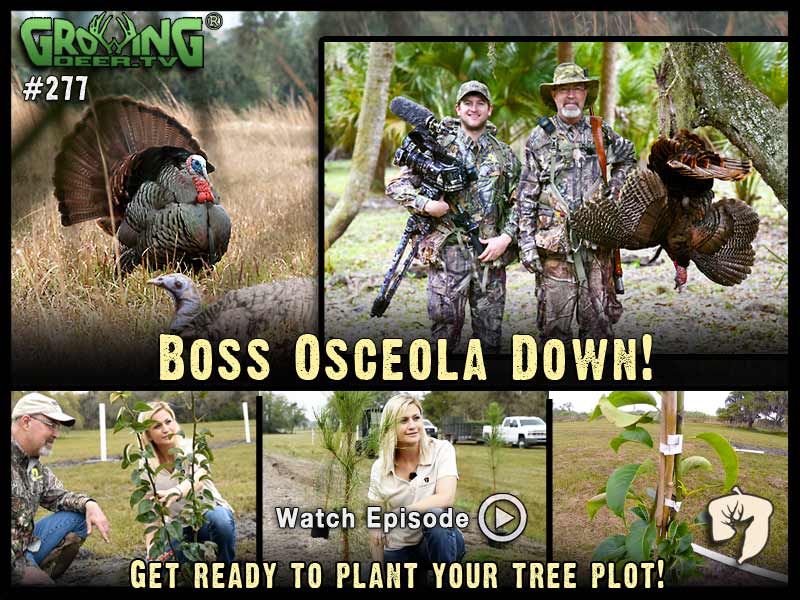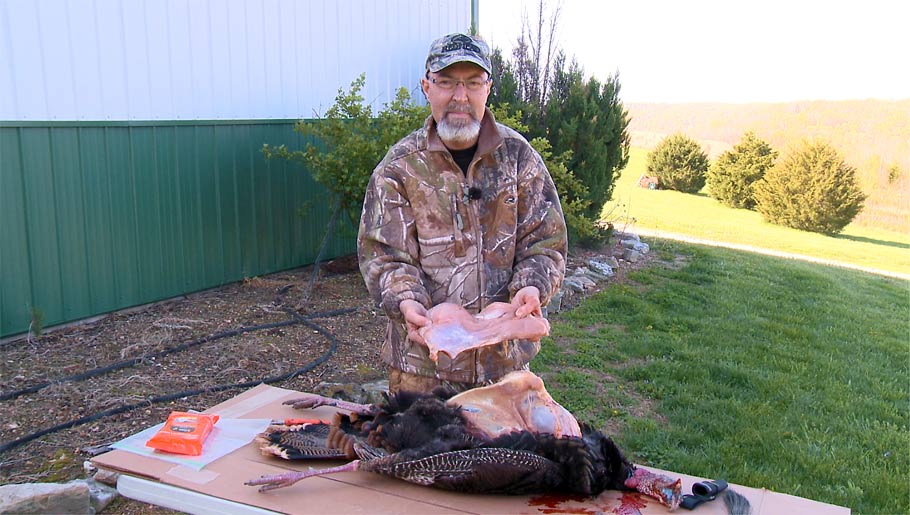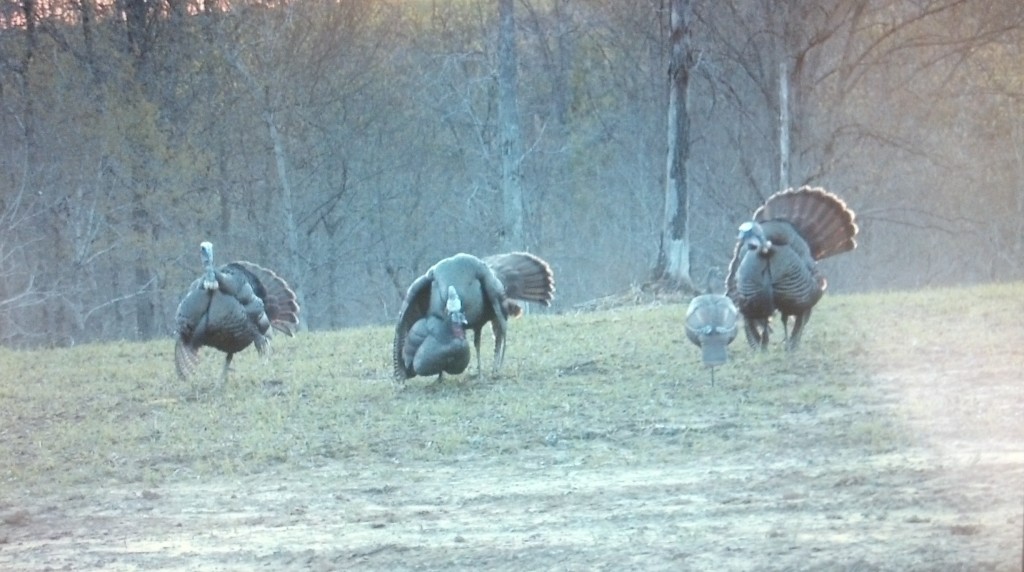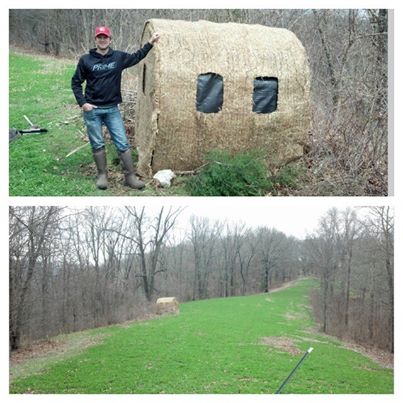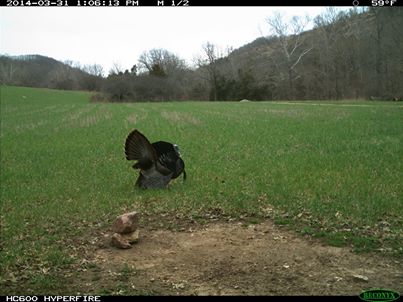Category: Turkey Hunting
Osceola Gobbler – Episode #277
Boss Osceola Down! We’ve seen Long Beard XR work to 70 yards on paper. What about 10 yards, on a real gobbler? Ouch. Watch to see a boss Osceola run to the Miss Purr-fect decoy and start strutting. You can imagine what happens!
Spring deer hunt? …Well, no, but we’ve got an awesome spring challenge for you. If you want extra power to hold fall deer then have something your neighbors do not. Spring comes a little sooner in Florida and it was a great chance for us to plant a tree plot. Sugary fruits and nuts are powerful natural attractants for deer.
Tip of the Week:
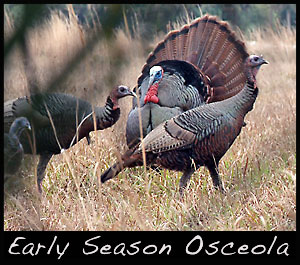
Decoy Hunting Tips
Early Season: Toms fight for dominance. Use strutting tom, with a hen or two.
Peak Breeding: Tired of fighting? A lone hen looks real good to a big ol’ tom.
Post Breeding: Tricky to hunt, try multiple hen spreads.
Turkey Decoys: When And Where
Using a turkey decoy has become a very popular tactic for turkey hunters. There are many variations to a turkey decoy: strutting tom, half strut tom, jake, strutting jake, alert hen, feeding hen, breeding hen, and a few others. With all of these different styles it usually brings up a set of questions, “Which ones do I use? How do I set them up?” Below are the guidelines I use every spring for my decoy setups.
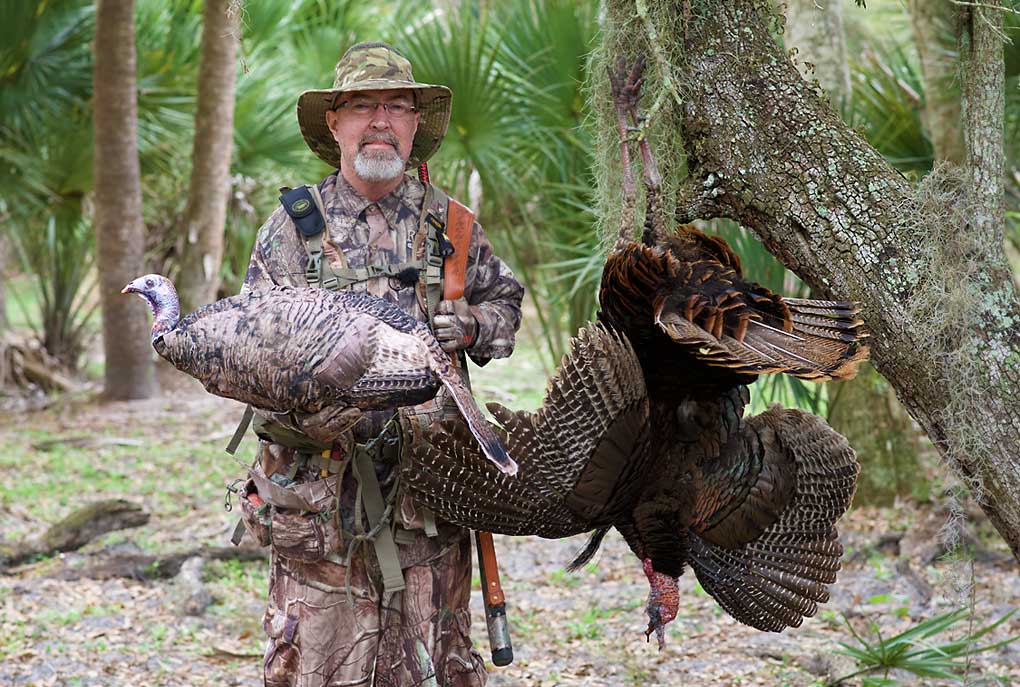
Grant was able to use the Miss Purr-fect to lure in a South Florida tom.
- Early Season or Pre Breeding – During this phase of the season dominance is the key. If the flock you’re hunting flies off the roost and walks into a field and every tom begins to strut, you’re best option is to challenge him with a strutting tom decoy with a hen decoy or two. They’re sorting out dominance this time of year and he won’t tolerate a new kid on the block, especially one with hens. As season progresses slightly, I will position the strutting decoy closer to a hen decoy, positioning the hen decoy in a breeder pose. If timed right, this approach can be deadly. This is the setup I use closer to peak breeding.
- Peak Breeding – When I see the toms and hens are starting to break off into smaller groups, I will start using a lone hen decoy. My favorite is the Montana Miss Purr-fect. Gobblers might be tired of fighting other toms during this phase. Using a lone hen will peak his interest and hopefully bring him into range.
- Post Breeding – This phase can be difficult to hunt sometimes. Hunting pressure can be high and the turkeys have sorted out dominance, finished most of their breeding, and the gobblers are focused on finding the last remaining hens to breed. The tom may have already seen the decoy spread for days and he’s not having any of it. This is where I’ll try and build his confidence and setup with multiple hens. Maybe 2 or 3 and sometimes 4, depending on the location. By using all of these hen decoys sometimes the gobbler can’t take the fact that there is that many hens and no gobbler and he’ll come in to investigate. The great thing about the Montana decoys is you can easily pack 5 hen decoys in your vest without weighting yourself down. During this phase you might need every trick in the bag to be successful.
To learn even more about decoy setup check out this cool turkey decoy setup guide at Montana Decoy.
Daydreaming of long spurs and long beards,
Adam
60 Yard Turkey Loads – Episode #276
There’s a lot of talk about Winchester’s Long Beard XR and for good reason. These revolutionary shells have changed the landscape of turkey hunting. This season, Winchester may have taken the Long Beard a step further with the new Long Beard XR Magnum. Watch this episode as we put the new magnum to the test. Plus, have you considered a hunting co-op for you and your neighbors? We did! Watch as the Branson Deer Co-op has its first gathering.
Tip of the Week: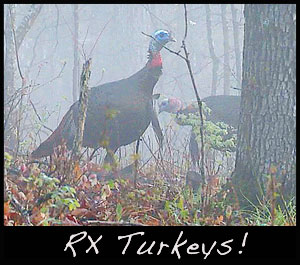
Late winter prescribed burning will make excellent turkey nesting & bugging habitat this spring. Prescribed fire now, for excellent hunting soon!
Winter Preparations For Spring Turkey Hunting
The GrowingDeer Team is excited because we are blessed to begin our turkey season March 7th. Flatwood Natives has graciously invited us to kick off our season chasing birds with them in Florida. As the first hunt approaches, we are not only preparing for Florida, we are also preparing for Missouri’s opener on April 20th. No matter when your season starts, you can start preparing now.
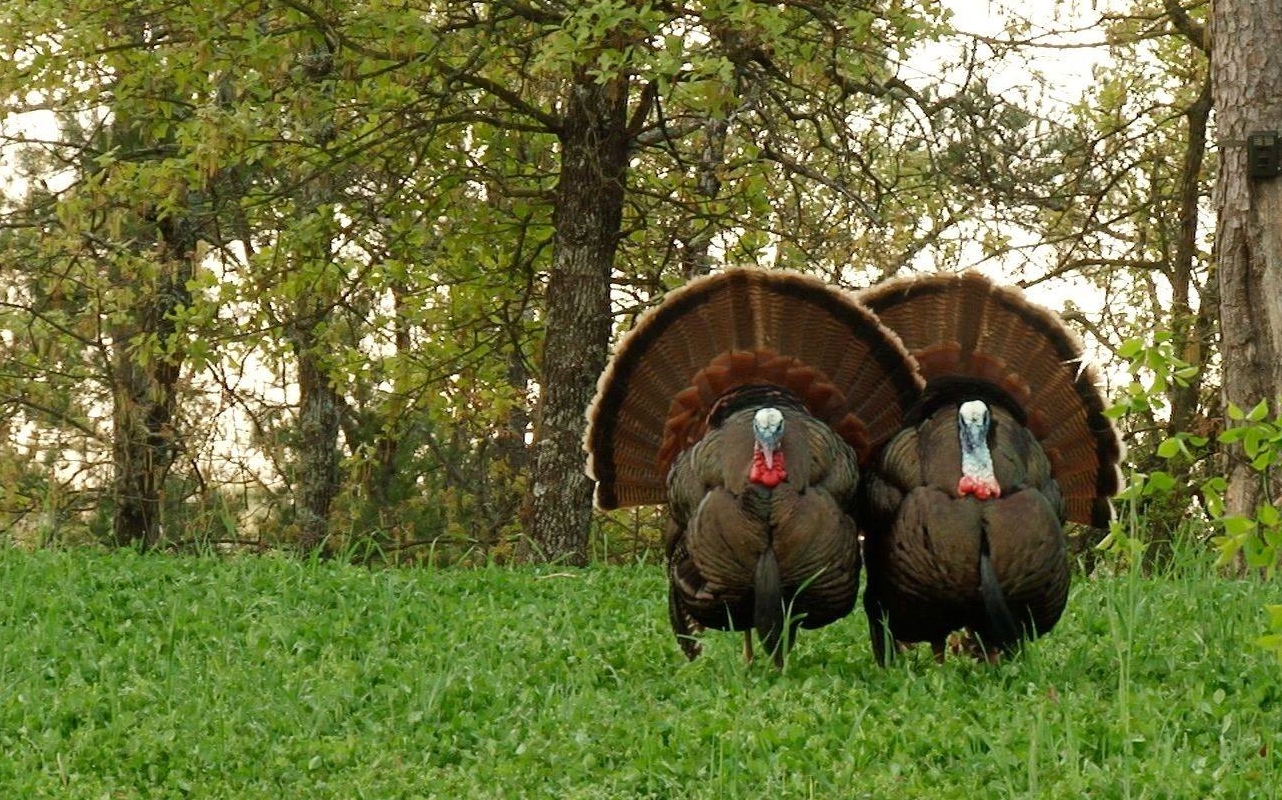
It takes the right combination of habitat, food, and calling for a great hunt.
You may have watched the recent unboxing video of Adam opening our new turkey calls from Hooks Custom Calls. We were excited to find several different diaphragm, slate, and locater calls. We have been using these cold winter days to get to know each call. By practicing our calling now and becoming familiar with our new hunting tools, we will be well prepared for turkey season. As turkey hunters/wildlife managers, we know it takes a great call AND quality habitat to get a long beard within range.
We recently burned several hardwood slopes that have established clover plots on the ridge tops above. We are excited! Burning is a known management tool for turkey, especially in the early spring, and can create great hunting opportunities.
By clearing the forest floor we have improved the property’s nesting habitat. As native forbs and grasses grow over the next few weeks, the burned area will become an ideal place for hens to lay their clutches, or eggs. Insects will also find the tender, new growth. The concentration of insects along with the ease which turkeys can now find them is a great food source. Ideal habitat, with an added source of food, close to a known strutting location can lead to great hunting later this spring.
Turkey season won’t get here soon enough! But we can use this time to improve habitat and practice our calling. If you do, you will be ready when toms leave the roost and hit the ground opening morning.
Managing whitetails with you,
Daniel Mallette
Wild Turkey: Ideas On How To Cook It
Yesterday a friend wrote asking for our favorite turkey recipe as his son had just shot his first ever wild turkey. Grant is off to shoot this weekend in the Total Archery Challenge with the crew from G5 so he has asked me (wife, Tracy) to write the blog. Many of our readers now have fresh turkey in their refrigerators and freezers so I will take this opportunity to share a recipe for cooking wild turkey.
(If you are unsure on how to remove the turkey breast from your recently tagged bird watch this episode of GrowingDeer.tv to see how Grant does it!)
It’s traditional for a lot of hunters to cut their turkey up and fry turkey “nuggets” or strips. We did this for many years but as we strive to eat healthier I’ve searched for different ways to prepare the meat. I’ve found the key to cooking wild turkey so that it isn’t tough is to slow cook it with enough liquid to almost cover it.
This year I created something new that the family just loves. It’s pretty easy and tasty, if you like a southwestern/Mexican type dish. It’s very flexible and can be modified based on your personal preferences. For instance, a can of black beans could be added if everyone in your family likes them (Grant doesn’t so I put them as a side dish instead of in the main dish). It can be eaten as a stew or the breast removed from the broth and chopped for burritos, enchiladas, quesadillas, tacos, or wraps. I guess it has to have a “name” so I’m going to call it…
Slow Cooker Southwestern Wild Turkey
One large crockpot (slow cooker)
Breast from a wild turkey
32 oz chicken broth (or enough to almost cover)
1 large can (28 oz) diced tomatoes (fire roasted or Rotel tomatoes to add an extra “zing”)
1 large can (29 oz) green chili enchilada sauce
1 4 oz can chopped green chilies
2 ½ tablespoons cumin
1 tablespoon chili powder (or to taste)
2 cloves finely diced garlic
2 teaspoons onion powder
1 medium onion and 1 medium green pepper chopped (can substitute a bag of frozen pepper/onion mix)
1 bag of frozen mixed vegetables (or 1 can corn, 1 can lima beans or green peas, 1 can green beans)
Cayenne or red pepper to taste
Black pepper
Cook for 6 to 8 hours on low in crockpot. For a little more southwestern flavor before serving add 1/4 cup lime juice and 1/2 cup chopped cilantro (cilantro is optional – some folks don’t care for it). Serve with shredded Colby-Jack cheese and traditional taco or burrito toppings of shredded lettuce, fresh chopped tomatoes, onions, refried beans, salsa, tortillas and/or tortilla chips.
One full turkey breast makes A LOT of food. We have it for several meals and also freeze portion sizes of it to have on hand for a quick future meal.
I hope your family enjoys this recipe!
Tracy
Turkey Hunting Strategies: Changing It Up
Even though we’re rolling into spring planting season and the Eagle Seed beans will be hitting the dirt soon, turkeys are still on the brain for the GrowingDeer team! It’s been a great season for us so far, and the season isn’t even over yet! Overall, it’s been a relatively strange year here in southern Missouri due to the late spring. Typically during Missouri turkey season the leaves are popped and almost fully developed, the dogwood blooms are in their final days, and the Redbud trees have lost almost all their blooms. The biggest difference between past seasons and this current turkey season is the amount of hens staying with toms throughout the morning. I’ve heard numerous people talk about the number of hens being with toms. They all mention the silence right after fly down, the unresponsive gobblers, and the overall tough hunting they’ve experienced.
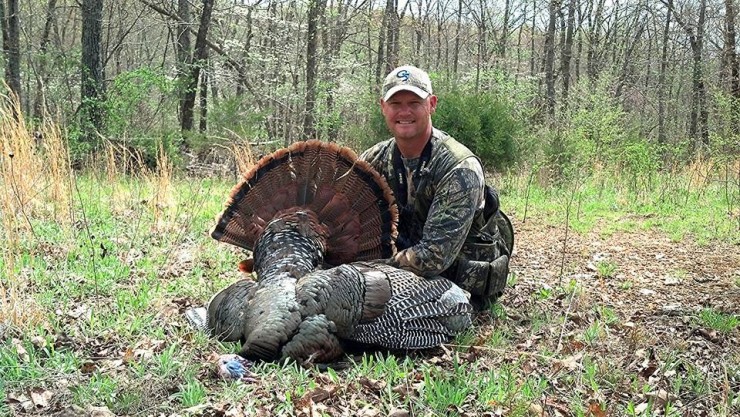
Adam Brooke, GrowingDeer Pro Staff, and Adam Keith enjoyed some mid-morning success by finding this lovesick tom.
The good news I’ll share with you is these turkeys will still respond to your calling and maybe even come into shotgun range, depending on your approach. Like I mentioned earlier, it’s been a great season for us thus far, but that doesn’t mean we haven’t shifted our game plan to adjust to these “henned up” toms. If we find ourselves hunting a tom that has hens with him first thing in the morning, but he’s still responding to our calls, we’ll wait him out! At some point during the morning the hens will begin to fade off and that’s when our tom will start gobbling more and become more susceptible to our calling. That’s why the mid-morning hunts can have such a high success rate during this period of the hunting season. We’ve had some great success this spring during the mid-morning hunts! One of the most exciting parts about mid-morning turkey hunting is that if a tom gobbles at your call, there’s a good chance he will come check you out!
I hope this helps you in your pursuit of the weary toms and you’re able to capitalize on a mid-morning tom!
Daydreaming of long beards and long spurs,
Adam
Turkey Hunting Strategies: Using Decoys In The Early Season
It’s been a fun week for the GrowingDeer Team and the fun is not over yet! I’m writing this from the Kentucky Proving Grounds this week as Grant, AJ, and I arrived yesterday afternoon ready to start chasing long beards. We were blessed enough to spend the beginning of the week near Tompkinsville, Kentucky hunting turkeys and staying at the beautiful River Breeze cabin. After a great hunt Wednesday morning, we loaded our gear and headed west to meet up with our friend Terry Hamby, owner of the Kentucky Proving Grounds.
When we arrived, Terry and his farm manager, Andrew Clifton, informed us that the turkeys were working really well. Terry’s grandson harvested a bird over a set of decoys just a few days prior. This brings up questions asked at thousands of turkey camps every spring, “When is the appropriate time to use decoys? When should I use a strutting decoy and when should I resort to just a hen decoy?”
First off I’ll say that every property is different due to hunting pressure, time of the year, and the overall attitude of the birds. Typically, I’ll only use a strutting decoy with a hen early in the season when dominance is still being sorted and the turkeys are still in larger flocks. As the season progresses and a number of turkeys have been whooped or kicked out of the flock, I will start using a semi strut or standing gobbler decoy along with a hen decoy. This is the setup we’re currently using at the Kentucky Proving Grounds. There are still flocks of birds in areas but also the occasional satellite tom roaming the area. Terry and I saw this first hand Thursday morning as we decoyed in a flock of hens and 3 big toms came to within 15 yards! You can watch that hunt unfold soon of GrowingDeer.tv! As the season starts to wind down and the turkeys have been pressured more, I’ll generally only use a lone hen decoy. This setup enables me to put the turkey eyes on a decoy and off of me. If used at the appropriate time all of the different setups can be extremely effective.
Daydreaming of long beards and long spurs,
Adam
Turkey Hunting: Blind Placement
Missouri youth season for turkey hunting opens tomorrow morning and hearts rates are increasing at The Proving Grounds. We love this time of year and we have done everything we know how to do to prepare. The shotguns are patterned, we’ve checked all Reconyx cameras, and the blinds are in place.
This week was a particularly exciting week to be setting up blinds. Every year we position our Redhead ground blinds and Redneck trailer blind in known hot spots, but this year we have a new addition to our blind repertoire. Monday we received two new Hay Bale Blinds from Redneck Blinds. We weren’t sure what to expect.
Let me be the first to say that they are AWESOME! Just two guys can easily move the blinds into place and they require no brushing in. My favorite things about the blind are the sliding windows and the magnetic door. They are silent! The blinds are large enough that we plan on hunting with three people and a camera in one blind during youth season. The windows have a “hay” side and a “black” side, so we flipped the sliding window to black side out. This will leave the blind looking the same whether it is being hunted in or not.
The Growing Deer Team will be out all weekend hoping to put a couple of long beards on the ground. I hope you have a chance to get out and do the same!
Chasing gobblers together,
Brian
Turkey Season!
Turkey season is open or will open soon in most states! Turkey season is a lot like deer season. In most states the spring turkey season is timed around the turkey breeding season. Just like deer, turkeys go through several distinct stages of a breeding season. In fact, gobblers go through behavior similar to the pre-rut, rut, and post rut. Click Here To Read More At Winchester.com
Youth Turkey Hunting: Passing On The Tradition
In Missouri we kick off the spring turkey season with a two-day youth hunt. In my opinion there is no better way to start off a hunting season. Hunting is a tradition and pastime that not only boosts the economy, but also connects people to their roots.
The Growing Deer Team is very serious about youth season, so how do we prepare for it? We start by placing all of our Reconyx trail cameras over food plots and setting them to time lapse. In time lapse mode the camera will take a picture every fifteen minutes throughout the day (depending on the settings). Also, we can see critters that may be too far to trip the motion sensor on the camera. The time lapse images reveal when and where turkeys are entering the field.
Once we know where the turkeys are entering the field we can place blinds that put Raleigh and Rae in position to harvest an elusive Eastern Turkey. We put a lot of work into scouting for youth season because we want the hunt to be enjoyable. If a youth hunt is enjoyable, regardless of a harvest, I consider it a success. The goal is to pass on the tradition of the hunt, a kill is secondary.
The team will be out this week listening for gobbles and positioning blinds. I hope you have a chance to put some time into scouting for the upcoming youth hunt. Make it fun, pass on the tradition, and give thanks to the Creator who made it all possible.
Chasing big gobblers together,
Brian



